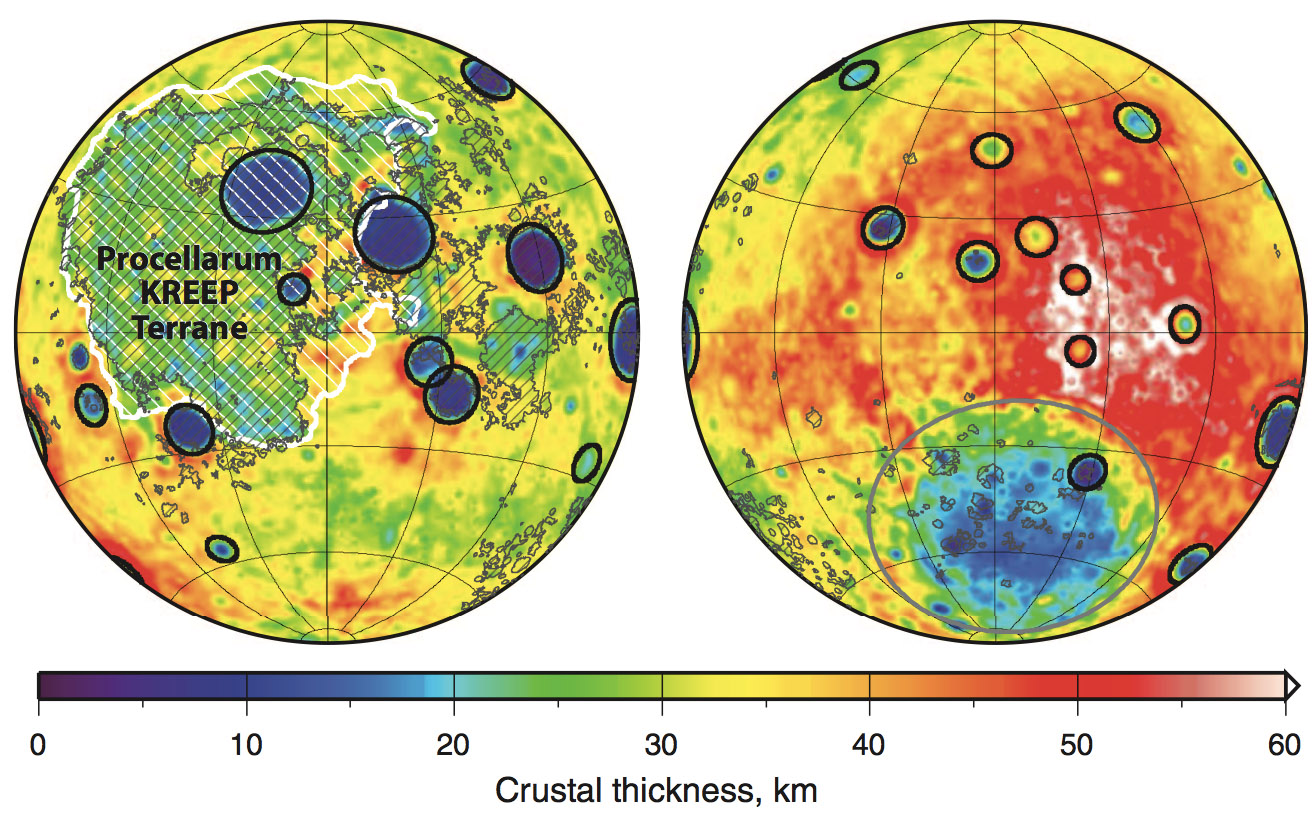November 15, 2013
Hot And Cold Basins

crustal thickness map from Katarina Miljković and colleagues, Science (2013)
One of the second order differences between the lunar nearside and farside (a thicker crust and the near lack of farside maria are first order differences) is that impact basins on the nearside are larger. This excludes, of course, the South Pole-Aitken basin (SPA) which is by far the largest on the Moon. Imbrium is said to be 1120 km in diameter, and the largest farside basin - Orientale, which is really half on the nearside -is 930 km wide. Overall the average nearside basin diameter is larger than the average farside diameter. But this statement is based upon trying to decide what is the actual formational diameters of basins. On the nearside the internal structure is commonly hidden by lava piles, and most basins have multiple rings so there is significant argument about the actual diameter of basins. Now a team of scientists using the GRAIL gravity data have used a new way to measure a fundamental diameter that they use as a proxy for basin diameter. The graphic above outlines the diameters of abrupt thinning of crustal thickness within basins. Inside the circles, crustal rocks have been excavated and dispersed as ejecta. Using this metric, nearside basins are still larger, on average, than farside ones, although not as big as thought from surface measures - for example, Imbrium's thinned hole is only 680 km wide. Farside basins are not smaller than their ring diameters suggest. Why the difference in sizes? Why are the nearside basins bigger than farside ones? The proposed solution is due to the extra heat available on the nearside, indicated by the Procellarum KREEP Terrane in the diagram. In this area the crust was presumable warmed - hence 99% of the Moon's mare basalts are there. Computer models predict that impacts into warm targets form basins nearly twice the diameter of impacts into cold targets. The reason is that during the modification stage, which follows the excavation stage, the warm crust has a more extensive rebound under the center of the basin, which limits how much the walls of the transient cavity can collapse. Since the crustal rocks of the walls can't move inward as much, the basin has a larger area of crustal thinning. This is a new idea that explains a mystery and it may be approximately correct. There are questions to ask and refinements to consider but the general result seems consistent with things known. One consequence is that the size range on incoming projectiles that made the lunar basins loses the high end - the average size of projectiles that formed the Moon may be a little smaller than we thought. Does that matter? I don't know.
Chuck Wood
Related Links
Katarina Miljković and colleagues (2013) Asymmetric Distribution of Lunar Impact Basins Caused by Variations in Target Properties. Science 342, 724-6.
Story and video.
Yesterday's LPOD: A Little Dose of Moonshine
Tomorrow's LPOD: Pythagoras South
COMMENTS?
Register, Log in, and join in the comments.



